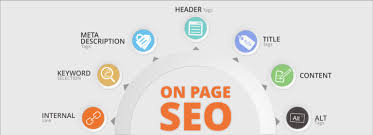SEO onsite optimization (also known as on-site SEO or on-page SEO) is the online marketing practice to optimize elements on a website which is based on the website’s content and relevant keywords in order to rank higher and earn more traffic from the search engines. Which means that on-site SEO refers to optimizing both the content and HTML source code of a webpage.
Other than making the search engines to interpret the page content of the target website, SEO onsite optimization if done properly will allow users to understand what a page is about and whether it addresses their search query efficiently. In short, effective on-site SEO will help the search engines to understand what the viewers will see and the results they would get if they visited a page online by giving them the high-quality content on the keywords aka search query.
Thus in short SEO onsite optimization is an online tool to make allow both the search engines and the users to understand what a webpage is all about by identify that particular page as relevant to a search query or queries using a particular keyword or set of keywords. Which is in return will make that webpage useful and worthy of ranking well for the search engine results page (or SERP in short).
It is also important to note that to make the page ranking higher for the targeted website, quality content is also important for the on-site SEO other than keywords. As the search engine’s algorithm is constantly evolving, the search engine can use the synonyms of the context and extract the webpage’s meaning or focus to the frequency in how the specific keyword’s combinations are used during the search query. Although using relevant keywords is still important, it is not necessary to use exact matching of the keywords for on-site SEO. Instead, the focus is the relevance of the keywords that are related to the website’s content during the search query.
To do a good SEO onsite optimization for your website, I have listed down the top 10 things to do and take note during the process.
- Using Keywords for the title tag
The title tag is one of the most important factors for on-site SEO which if the relevant keywords are inserted correctly, the pages ranking will rise as Google’s algorithm has place priority on the title tag in order to identify the web page and doing it correctly increase the SERP results in the search engine.
- How to increase visibility with SEO-Friendly URLs
During the creation or editing process of the new webpage, take note to include an URL that is SEO-friendly and can use the keyword phrases naturally to explain what the webpage is about. This increase the SEO value for both search engines and users by making the URL easier to understand. Making the keywords simple and recognizable is also important as it will affect the page ranking.
- How to wrap your Titles in H1 Tags
H1 tags are used and show in the Headline in the search engine and thus the title must be wrapped around this tag. It is important not to over-optimize the targeted webpage by using additional keywords to sub-headings in the H2, H3, and H4 tags with the purpose of H tags is to inform the search engine how the content is structured for readability. Thus, the title is meant to describe the topic of the post which is followed by sub-headings that further explains into detail about the content.
- Using of Structured Data Markup
While “feeding” the search engines with as much information as possible about the targeted website and the information within will increase your SEO performance. To outrank the competition in the search engines, it is vital to use structured data markup which is also known as rich snippets to enhance the search engine listings. Additional benefits of using structured data can help the website to improve the CTR (click through rate) in the SERPs for better SEO performance.
- Internal Linking with Anchor Text
To allow the search engines and users to go deeper into the target website, it is important to link the webpage using anchor text that prompt user for action or phasing keywords naturally. Examples such as “call us now”, “Download our information Guide” will direct users to the specific site when they click on the link. Try not to overwhelm the user with too many links as it may backfire the process.
- Writing Meta Description that focus on Feature
The standard length is 150 characters that you can write in the Meta description (numbers and symbols included) and is considered as one of the most important tools in SERPs. The reason is due to the fact that it’s the only part in the search engine where the website owners can do the advertisement for free without SEM. Thus the contents for the Meta description must be precise and straightforward with the description of the company’s brand name, business nature and products or services to attract online viewers to click on the link.
- Adding of Outbound Links
Outbound links are a valuable asset for webmasters and site owners for their SEO campaigns and by linking out to other websites within the same industry for reference purpose will have a positive impact for the sites SEO ranking.
Not only that, outbound links will send out a signal and make it easier for the search engines to interpret the targeted website’s content and also shows that increasing the value for the viewers giving additional information.
- Usage of Natural Language
While it is crucial to mention the keyword phrases several times naturally in the content, utilizing the contextual variations also known as Latent semantic indexing(LSI) is also important as the closed variant keywords and the synonyms determine the page’s relevancy by the search engine.
For example, if the business owner is working on a landing page that description Organic salad. It will be the best practices for SEO to indicate the phrase “Organic salads” in the content including related phrases like “Fresh salad”, “Healthy salad”.
Once done, it will be good to do a litmus test by reading the content verbally to determine if the content sounds naturally in conversation to ensure the content ranks well in SEO page ranking.
- Increase your content length
Writing a lengthy content will increase the SEO ranking. A quality blog usually has between 350 to 500 words and an article will have between 500 and 1000 words. But the author has to ensure that he or she include relevant contents and keywords phrase to optimize the webpage which the content are inserted., it’s about finding the right balance between word count and value offered.
Contents that are rich in information and meet the requirements of the visitors with rank better in the page ranking as it increases the visibility of the website in the search engines.
- Optimizing the Images
When using images on your pages, make sure that they are not only relevant to the topic, are clear, interesting with relevant alt text and captions. Also, note that using a descriptive name for your images as is important for Image SEO.
Since most images taken by the cameras or mobile phones will give a generic name to the images taken such as DCAIAG5.jpg. do make it a practice to name the file with a product or service name that match the title tag. After that, you will need to optimize the ALT Text (text alternatives in short) in the images after uploading to the content so the search engines can learn these images and associate the related keywords with images to have better page ranking in the search results.
There are actually more things to do and learn for SEO onsite optimization such as how to write quality content, adding of social buttons for social media purpose, how to increase the site speed responsive designs, better readability of the content and so on. But for now, knowing the basic on how to do the on-site SEO in this article will have a good start for business owners to learn more about the process of SEO.




